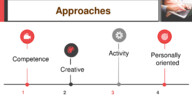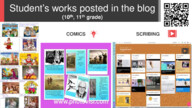 | EasyChair Smart Slide | User Guide/Log in |
| Home |

The article focuses on forming the information and communication competence of upper secondary school pupils. The meaning of an “information and communication competence of pupil” (IC-competence of pupil) is pointed out. The importance of blended learning and on-line learning is substantiated. The possibilities of introducing new types of ICTs into education, peculiarities of their application are characterized. In the process of experimental study, the tasks developed using on-line resources are tested (“LearningApps”, “Prezi”, “Emaze”, “PoowToon”, “Kizoa”, “Padlet”, “Thinglink”, “Piktochart”, “Tagul”, “Canva”, “Realtimeboard”, “Mindmeister”, “Mindomo”, “Ilovefreesoftware”, “Zaption”). It has been found out that these tasks and the selected on-line resources contribute the analysis and interpretation of artistic works. It is also crucial to use Google as a searching tool for pupils in the process of their educational activity. The upper secondary school pupils’ cross-cutting skills, which promote the forming pupils’ IC-competence, are determined. The cross-cutting skills give the opportunity to work in standard and updated conditions. The ICT potential of the new generation is revealed in samples of artistic works. There are examples of using the Internet resources for the purpose of forming the IC-competence of upper secondary school pupils. The effectiveness of the tasks which form an IC-competence of pupils has been verified. Thanks to implementing new kinds of ICTs, teaching the upper secondary school pupils has become more qualitative, and forming the IC-competence of pupils has become more effective. The article also deals with other results of an empirical research carried out among the upper secondary school pupils.





















